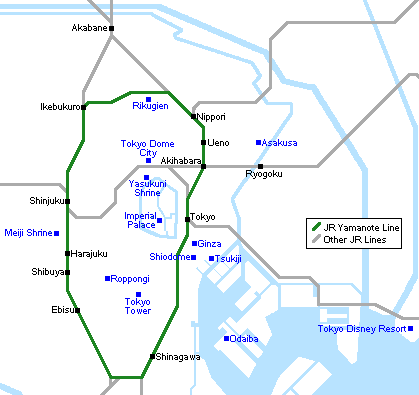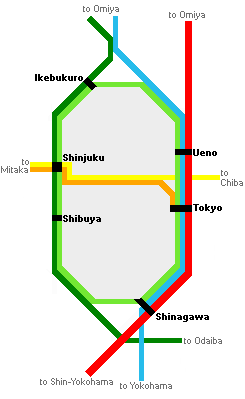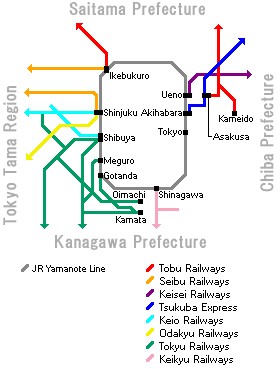How to get to TokyoBy Air - Tokyo has two airports: Narita Airport, which handles the majority of international flights, is located 60 km outside of central Tokyo, while Haneda Airport is located more centrally.
By Shinkansen - Most shinkansen (bullet train) lines lead to Tokyo. The trip from Osaka/Kyoto takes about three hours. There are also direct bullet trains to/from Kyushu, Nagano, Niigata and various destinations in the Tohoku Region.
Basic Orientation
Tokyo is covered by a dense network of train, subway and bus lines, which are operated by about a dozen different companies. The train lines operated by JR East and the subway lines are most convenient for moving around central Tokyo.
Tokyo's most prominent train line is the JR Yamanote Line, a loop line which connects Tokyo's multiple city centers. The city's 13 subway lines are operated by two companies and run largely inside the Yamanote circle and the areas around Ginza and Shitamachi. Most of the many suburban train lines commence at one of the six major stations of the Yamanote Line (Tokyo, Ueno, Ikebukuro, Shinjuku, Shibuya and Shinagawa).

Major JR train lines in Central Tokyo
The map below shows Tokyo's major railway stations and the five JR lines that are most relevant to people who travel within central Tokyo.
 | Yamanote Line
Circle line that connects all major city centers.Keihin-Tohoku Line
Runs parallel to the Yamanote Line on the eastern half of the circle.
Chuo/Sobu Line
Runs across the Yamanote circle (local slow service).
Chuo Line (Rapid)
Runs across the Yamanote circle (rapid service). Connects Tokyo and Shinjuku.
Saikyo/Rinkai Line
Rapid service parallel to the Yamanote Line on the western half of the circle. Connects to Daiba.Shinkansen
Tokaido Shinkansen trains stop at Tokyo and Shinagawa, while bullet trains to the north stop at Tokyo and Ueno. |
Subways
Tokyo's subway network is operated by two companies, the Toei Subways with four lines, and Tokyo Metro (formerly known as Eidan Subways) with nine lines. Together, they densely cover central Tokyo, especially the area inside the Yamanote circle and the areas around Ginza and Shitamachi.
Note, that at their terminal stations, the trains of some subway lines continue to operate on the tracks of different companies on suburban train lines. For example, the Chiyoda Subway Line is directly connected with the suburban Odakyu Line at Yoyogi-Uehara Station, and some trains on the Hibiya Subway Line continue to run on the tracks of the Tokyu Toyoko Line at Nakameguro Station.
Other railway companies
Besides JR East and the two subway companies, most other railway companies connect Tokyo with the metropolis' outer regions and surrounding prefectures. Their lines typically start at one of the stations of the JR Yamanote Line. Many of the private railway companies also operate department stores usually at their train lines' major stations.
Special Tickets
Prepaid cards don't give you any discounts over single tickets, but they make the process of taking trains easier, as you do not always need to buy a ticket before riding a train.
 | Suica and PASMO |
| | Suica and PASMO are prepaid IC cards, that can be used interchangeably on most trains and buses in Greater Tokyo, including JR trains, subways and other non-JR trains. View our page onSuica and PASMO for more details. |
A whole variety of day passes is available for the Tokyo area, however, most of them are overpriced or not very practical because they do not cover all of Tokyo's train and subway lines. Consequently, single tickets or prepaid cards usually come cheaper, especially if you plan your city sightseeing in a geographically wise way. Day passes are sold at train stations and vending machines and are valid from the first train in the morning until the last train in the evening rather than for a 24 hour period.
 | Tokyo Free Kippu (1580 yen) |
| | Unlimited use of all subway lines (Toei and Tokyo Metro) and JR trains in the central Tokyo area on one calendar day. It is also valid on buses and streetcars operated by Toei. The pass is overpriced and will unlikely provide any savings over regular tickets or prepaid cards. |
 |
 | Toei and Tokyo Metro One-Day Economy Pass (1000 yen) |
| | Unlimited use of all subway lines (Toei and Tokyo Metro) on one calendar day. The pass only pays off if you use the subways excessively. The pass is not valid on JR trains. |
 |
 | Tokyo Metro Open Ticket (1-day: 600 or 710 yen; 2-day: 980 yen) |
| | Unlimited use of the nine Tokyo Metro subway lines, but not the four Toei subway lines and JR trains. A regular one day pass costs 710 yen, while a tourist version is available for 600 yen (one day) and 980 yen (two consecutive days). The tourist version is only available at Narita Airport. |
 |
 | Toei One-Day Economy Pass (700 yen) |
| | Unlimited use of the four Toei subway lines, buses and streetcars on one calendar day. It is not valid on the nine Tokyo Metro subway lines and JR trains. |
 |
 | Tokunai Pass (730 yen) |
| | Unlimited use of JR trains in the central Tokyo area on one calendar day. |
 |
 | Holiday Pass (2300 yen) |
| | Unlimited use of local and rapid JR trains in the greater Tokyo area (including Yokohama andKamakura) on one calendar day. It can only be used on Saturdays, Sundays, public holidaysand certain holiday seasons. Elsewhere on the site is a guide devoted to the Holiday Pass. |
The Japan Rail Pass is valid only on JR trains. It cannot be used on subways or any other non-JR train. |









No comments:
Post a Comment